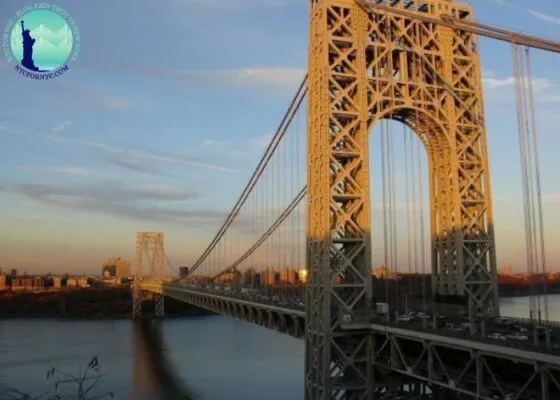New Jersey, nestled in the Mid-Atlantic region of the United States, is renowned not only for its stunning beaches and vibrant cities but also for its magnificent and historically significant bridges. These architectural marvels are not just crucial for transportation, connecting different areas, but also serve as cultural symbols and captivating tourist attractions. Let’s explore the most famous bridges in New Jersey, where each span tells a unique story of engineering, history, and human endeavor.
1. George Washington Bridge
The George Washington Bridge is more than just a vital transportation artery; it’s an iconic architectural symbol spanning the Hudson River, connecting the bustling borough of Manhattan in New York City with Fort Lee, New Jersey. Considered a masterpiece by chief engineer Othmar Ammann and architect Cass Gilbert, this bridge harmoniously blends engineering prowess with aesthetic beauty.
Opened in 1931, the George Washington Bridge quickly established itself as one of the busiest bridges in the world, with an estimated daily traffic volume of nearly 300,000 vehicles. The grandeur of this structure lies not only in its size but also in its pivotal role in the region’s transportation network. Featuring a unique double-deck design, the George Washington Bridge boasts a total of 14 lanes, evenly distributed across both decks, optimizing traffic flow and minimizing congestion. Additionally, the bridge includes dedicated lanes for pedestrians and cyclists, providing convenient access for those wishing to enjoy the breathtaking views from the bridge.

Specific Address: George Washington Bridge, Fort Lee, NJ 07024, USA
2. Bayonne Bridge
The Bayonne Bridge is an impressive steel arch bridge linking Bayonne, New Jersey, and Staten Island, New York. This structure stands as a testament to the remarkable advancements in bridge construction techniques in the early 20th century. Designed by the talented engineer Othmar Ammann, who also spearheaded the success of the George Washington Bridge, the Bayonne Bridge embodies a powerful beauty and enduring strength.
Construction began in 1928, and upon completion in 1931, the Bayonne Bridge held the record for the world’s longest steel arch bridge until 1977. With a main span of 510 meters, the bridge is not only an admirable engineering feat but also a unique architectural highlight in the regional landscape. The Bayonne Bridge plays a crucial role in connecting transportation between New Jersey and New York, serving as a vital artery for both freight and passenger traffic.
Specific Address: Bayonne Bridge, Bayonne, NJ 07002, USA
3. Outerbridge Crossing
The Outerbridge Crossing is one of three bridges operated by the Port Authority of New York and New Jersey connecting New Jersey with Staten Island, New York. This bridge spans the Arthur Kill strait, serving as a vital part of Interstate 440. The name “Outerbridge” is derived from Eugenius Harvey Outerbridge, the first chairman of the Port Authority of New York.
Opened in 1928, the Outerbridge Crossing is a steel cantilever bridge, offering a sleek and modern aesthetic. Along with the Goethals Bridge and Bayonne Bridge, the Outerbridge Crossing forms an essential transportation corridor, driving economic and social development in the region. The bridge not only caters to the daily commuting needs of residents but also serves as a crucial route for transporting essential goods between the two states.
Specific Address: Outerbridge Crossing, Perth Amboy, NJ 08861, USA
4. Goethals Bridge
The Goethals Bridge is a twin-span bridge complex crossing the Arthur Kill strait, connecting Elizabeth, New Jersey, and Staten Island, New York. The bridge is named after Major General George Washington Goethals, the chief engineer of the Panama Canal Project, a monumental achievement of the 20th century. The Goethals Bridge plays a vital role in alleviating traffic pressure on other routes and facilitating trade and tourism.
The original Goethals Bridge was inaugurated in 1928, concurrently with the Outerbridge Crossing and Bayonne Bridge, forming a critical trio of bridges for the Port Authority of New York. However, due to increasing traffic demands and the deterioration of the old bridge, a project to construct a new Goethals Bridge was initiated. The modern Goethals Bridge complex, featuring advanced design and greater load capacity, officially opened in 2018, replacing the old bridge and better meeting current and future transportation needs.
Specific Address: Goethals Bridge, Elizabeth, NJ 07201, USA
5. Delaware Memorial Bridge
The Delaware Memorial Bridge is actually a pair of majestic twin suspension bridges spanning the Delaware River, connecting the states of New Jersey and Delaware. It is a prominent architectural landmark and a symbol of the Mid-Atlantic region. The Delaware Memorial Bridge is not only a vital transportation route but also a tourist destination, attracting visitors with its magnificent beauty and panoramic views of the surrounding landscape.
The first bridge of the Delaware Memorial Bridge complex opened in 1951, and the second twin bridge was built and completed in 1968 to accommodate increasing traffic volume. With a total length of nearly 3.2 km, the Delaware Memorial Bridge is one of the longest and most impressive suspension bridge systems in the United States. This structure not only serves the commuting needs of residents in both states but also plays a crucial role in the federal transportation network, connecting key economic areas.
Specific Address: Delaware Memorial Bridge, New Castle, DE 19720, USA (Delaware side, bridge connects to New Jersey)
The famous bridges of New Jersey are more than just transportation structures; they are works of art, historical witnesses, and cultural icons of the region. They connect people, link the past with the present, and pave the way for new horizons in the future. We hope this article has provided you with a comprehensive and insightful look into the beauty and significance of these unique bridges.